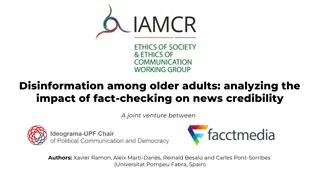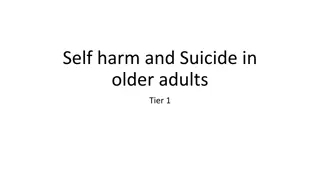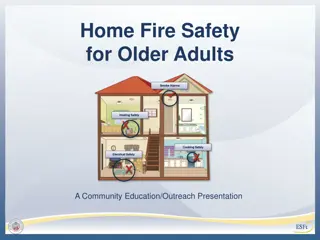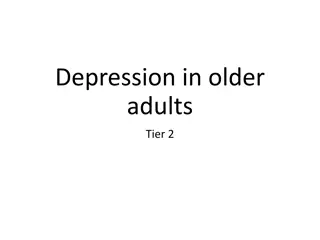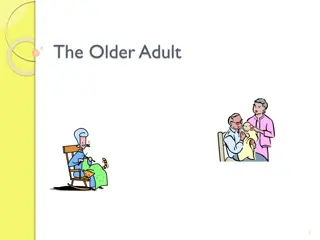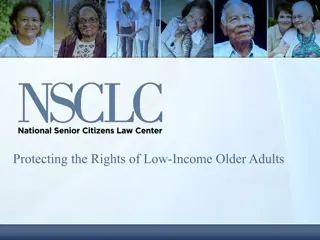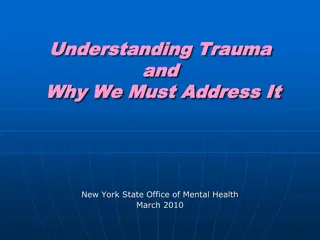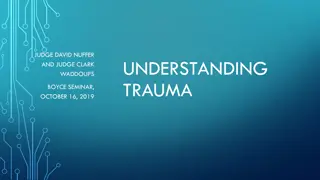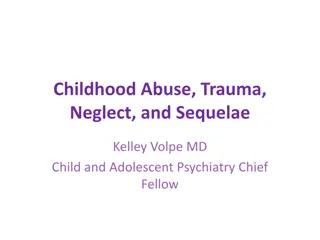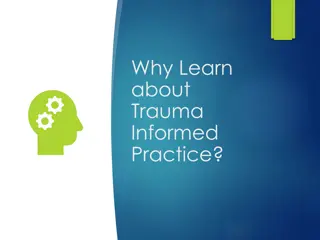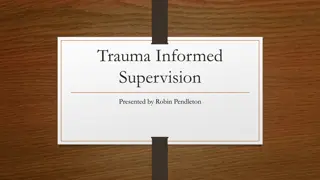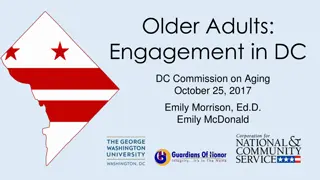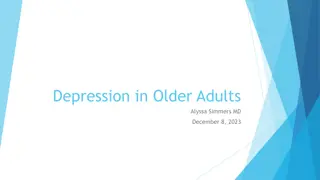Understanding Trauma in Older Adults: Importance and Approaches
Trauma in older adults is often unrecognized and undertreated, leading to significant adverse effects on their well-being. It is crucial to realize that trauma can affect up to 90% of older adults, and recognizing signs, responding appropriately, and preventing re-traumatization are key in supporting their mental, physical, and emotional health. Possible triggers to traumatic memories should be understood, and symptoms of past trauma, such as intrusive recollections and irritability, need to be recognized for effective intervention.
Download Presentation

Please find below an Image/Link to download the presentation.
The content on the website is provided AS IS for your information and personal use only. It may not be sold, licensed, or shared on other websites without obtaining consent from the author. Download presentation by click this link. If you encounter any issues during the download, it is possible that the publisher has removed the file from their server.
E N D
Presentation Transcript
Trauma in older adults Tier 3
What is trauma? Individual trauma results from an event, series of events, or set of circumstances that is experienced by an individual as physically or emotionally harmful or life threatening and that has lasting adverse effects on the individual s functioning and mental, physical, social, emotional, or spiritual well-being.
Trauma in older adults Trauma is under-recognised Trauma is under-treated Older adults may fail to report or minimize traumatic experiences
Four Rs of a trauma focussed approach Realisation that trauma can affect older adults Recognition of the signs of trauma Responding to the trauma so that the person feels safe physically, psychologically and emotionally Resisting re-traumatisation by understanding the triggers for the memories and preventing them Remember the goal is not for the older adult to disclose any or all details but rather to feel safe, develop trust and ultimately become improve their functioning
Realisation that trauma can affect older adults Up to 90% of older adults have experienced at least one traumatic event in their lifetime Examples include evacuation in the war, the unexpected death of someone close, serious illness or serious injury to self etc. As a result of the previous trauma the person can find that situations that occur in everyday life may trigger memories of the trauma and affect the person s responses If you are unable to ascertain that there is a history of trauma the best approach is to assume there is
Triggers to traumatic memories Possible triggers to traumatic memories could be: A particular date anniversary of a traumatic bereavement A rigid regime with in a care setting reminding them of being in a prison camp A particular place/noise reminding them of past physical abuse
Recognition of past trauma Possible symptoms of past trauma include Intrusive distressing recollections/thoughts Recurrent distressing dreams Irritability and sleep disturbance Flashbacks in which it can feel like the event is reoccurring Distress when exposed to triggers symbolizing or resembling the trauma Intense physiological reaction to trauma triggers Avoidance of activities/places which provoke thoughts/feelings about the trauma Negative beliefs and expectations
Question How to ask about trauma in older adults Some people have told me about difficult experiences they had during their lifetimes, such as being threatened or assaulted. Has anything like that ever happened to you?
Responding if trauma is mentioned It is appropriate to express your care and concern: I am sorry that this has happened to you. You will need to allow the person extra time so you can listen to them Validate the response: That must have been very frightening . Normalise the response: You are not alone , I know that this has happened to others but don t minimize the trauma You should not respond by questioning the person and asking did that really happen? It is often inappropriate to probe the person for details at this point
Resisting re-traumatisation Ensure that if this trauma is new information to your care team that it is reported. Assess and then care plan with the aim to reduce or prevent re- traumatisation by understanding the triggers for the traumatic memories and preventing them.
Guiding principles to prevent re- traumatisation Create a physically and emotionally safe environment Establish trust Support autonomy and choice Create collaborative relationships and participation opportunities Use a strengths and empowerment-focused perspective to promote resilience and reduce re-traumatisation and promote healing
Overview of techniques to intervene and treat trauma in older adults Techniques include Psychological First Aid Developing skills for Psychological Recovery Trauma-focused Cognitive Behavioural Therapy Exposure therapy EMDR (eye movement desensitisation and reprocessing), life review and narrative
Psychological First Aid It is like medical first aid It can be used by non-clinicians It is an evidence based approach designed to reduce the initial stress caused by traumatic events and to foster short and long term adaptive functioning
Skills for psychological recovery Give information about common physical and psychological reactions to crisis Provide education around stress and coping Help to restore the individual s sense of control Encourage increased networking and re-establishment of contact with informal and formal support
Trauma-focused Cognitive Behavioural Therapy This therapy is based on using a range of psychological techniques to help the person come to terms with the traumatic event. Identification of the unhelpful thoughts as a result of the trauma Evaluation of the validity of these thoughts and challenging those thoughts that are incorrect Replacement of the dysfunctional thoughts with more helpful ones Usually there is an exposure element and cognitive therapy element
Eye movement desensitization and reprocessing (EMDR) This involves the person making side-to-side eye movements, usually by following the movement of the therapist's finger, while recalling the traumatic incident. Other methods may include the therapist tapping their finger or playing a tone. It's not clear exactly how EMDR works, but it can help change the negative way the person thinks about a traumatic experience.
Resources MPC_08_01 - Post Traumatic Stress Disorder And Other Traumas | Effects of Trauma (mindedforfamilies.org.uk) This is an easy to access website for older adults and their families which has good advice about what trauma is ,the effect of trauma , post traumatic stress disorder and practical suggestions of things that could help.




